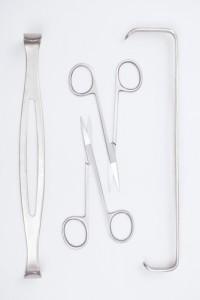Surgical instruments made using 3D printers could provide desperately-needed equipment in developing countries at a fraction of the cost of traditional stainless steel instruments.
 Researchers from the University of Arizona tested the feasibility of the approach by using a MakerBot Replicator 2 modeling printer to create a widely-used instrument – called an Army-Navy surgical retractor – out of polylactic acid (PLA) filament. PLA is already approved for use in the manufacturing of medical devices such as dermal fillers.
Researchers from the University of Arizona tested the feasibility of the approach by using a MakerBot Replicator 2 modeling printer to create a widely-used instrument – called an Army-Navy surgical retractor – out of polylactic acid (PLA) filament. PLA is already approved for use in the manufacturing of medical devices such as dermal fillers.
The 3D-printed retractor underwent sterilization with glutaraldehyde – a standard procedure recommended by the Food and Drug Administration (FDA) for medical devices – as well as testing for bacterial contamination and a battery of stress tests to make sure it could stand up to the rigors of an operating theater.
It took around 90 minutes to print the retractor, using less than 50 cents-worth of PLA, and the team found that the freshly printed instrument was completely sterile. That means that if it was printed directly onto a sterile surface in clean environment such as an operating room, it could – at least in theory – be ready for use straight away without sterilization.Best of all, the retractors can be made extremely very cheaply. “Our estimates place the cost per unit of a 3D-printed retractor to be roughly one tenth the cost of a stainless steel instrument,” write the researchers in the Journal of Surgical Research (15 June edition).
There is a host of research being carried out on 3D-printed materials for use as implants, scaffolds or surgical guides, but little effort has been made to produce instruments that, despite being mundane and in almost ubiquitous use, are often in short supply in the developing world, say the researchers.
A 2010 survey estimated that around a third of people living in low-income countries – more than two billion individuals – have almost zero access to essential surgical services, mainly because of a lack of access to facilities or basic equipment. The survey by Harvard School of Public Health also predicted that the situation is likely to get worse as the health demands of emerging nations evolve, with a shift from communicable to chronic diseases – such as cancer – which typically require surgery. Moreover, that trend is only likely to continue as the world’s population ages.
“Because of the unprecedented accessibility of 3D printing technology worldwide and the cost efficiency of these instruments, there are far reaching implications for surgery in some underserved and less developed parts of the world,” according to the University of Arizona scientists.
Of course, access to 3D printers is patchy at best in the emerging economies of Africa, Latin America and Asia. However, as the cost of machines falls – and other factors such as access to electricity and the Internet improves – it is at least feasible that the approach could allow instruments to be made on demand, even in remote hospitals.
 The researchers estimate they would only need to make 95 retractors to cover the cost of printing and make each unit cost the same as a stainless steel version, which are typically around $47 for a pair. Running it for a week would pay for the printer itself, and once the number of retractors printed neared a thousand the cost per unit could be as little as $2.77.
The researchers estimate they would only need to make 95 retractors to cover the cost of printing and make each unit cost the same as a stainless steel version, which are typically around $47 for a pair. Running it for a week would pay for the printer itself, and once the number of retractors printed neared a thousand the cost per unit could be as little as $2.77.
“Not only does the low cost of this new technology make it accessible but also the potential cost savings may make it fiscally responsible,” they conclude.
The MakerBot Replicator 2 was priced at $2,199 at the time the research went to press. What do you think? Can 3D printing plastic medical devices, allow for a the spread of important medical equipment to countries not typically able to afford them, thus boosting the number of surgical procedures available? Let’s hear your opinion in the 3D Printed Medical Device forum thread on 3DPB.com.
Subscribe to Our Email Newsletter
Stay up-to-date on all the latest news from the 3D printing industry and receive information and offers from third party vendors.
You May Also Like
3D Printing Unpeeled: New Arkema Material for HP, Saddle and Macro MEMS
A new Arkema material for MJF is said to reduce costs per part by up to 25% and have an 85% reusability ratio. HP 3D HR PA 12 S has been...
3D Printing News Briefs, January 20, 2024: FDM, LPBF, Underwater 3D Printer, Racing, & More
We’re starting off with a process certification in today’s 3D Printing News Briefs, and then moving on to research about solute trapping, laser powder bed fusion, and then moving on...
3D Printing Webinar and Event Roundup: December 3, 2023
We’ve got plenty of events and webinars coming up for you this week! Quickparts is having a Manufacturing Roadshow, America Makes is holding a Member Town Hall, Stratafest makes two...
Formnext 2023 Day Three: Slam Dunk
I’m high—high on trade show. I’ve met numerous new faces and reconnected with old friends, creating an absolutely wonderful atmosphere. The excitement is palpable over several emerging developments. The high...
































